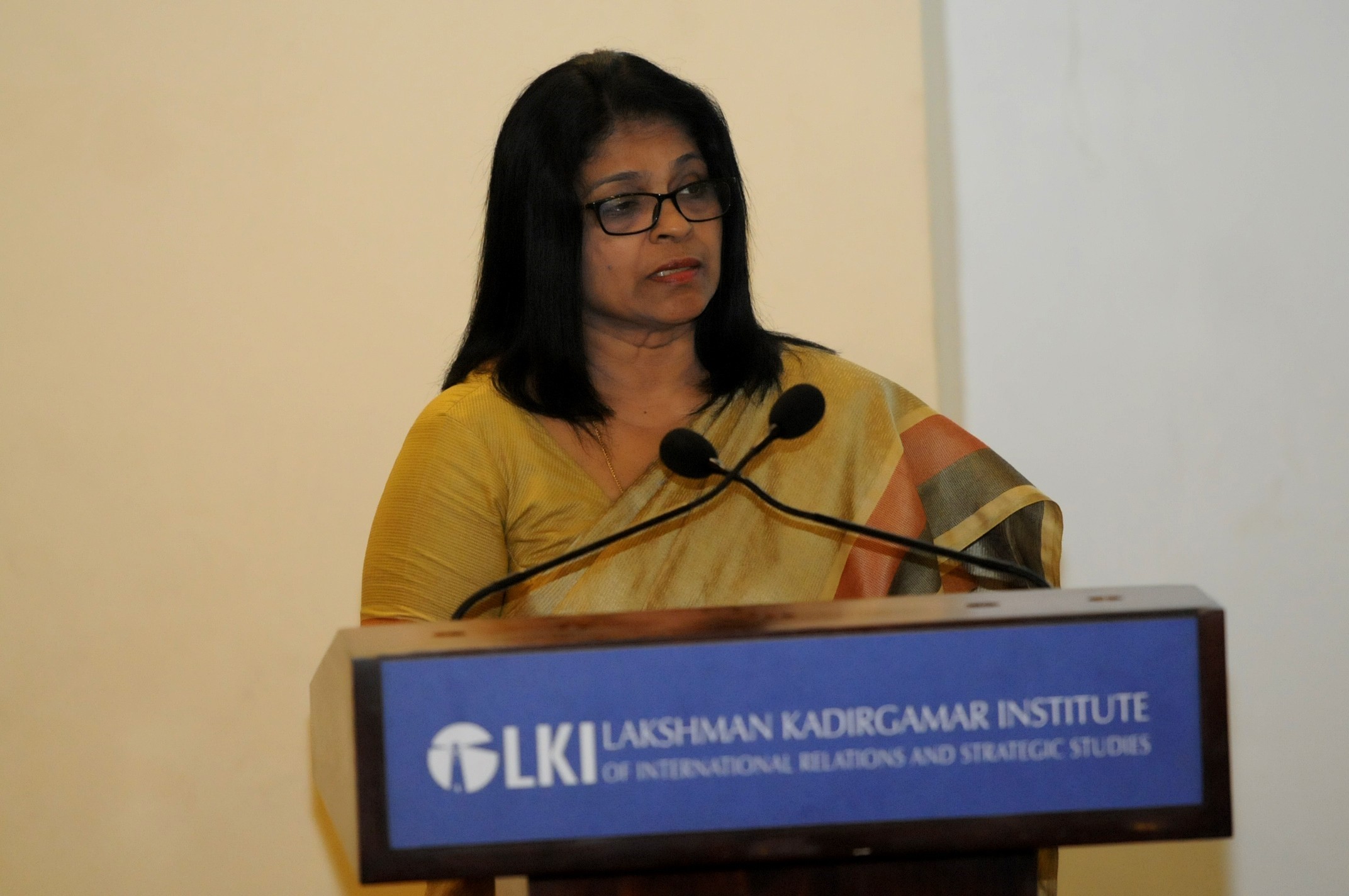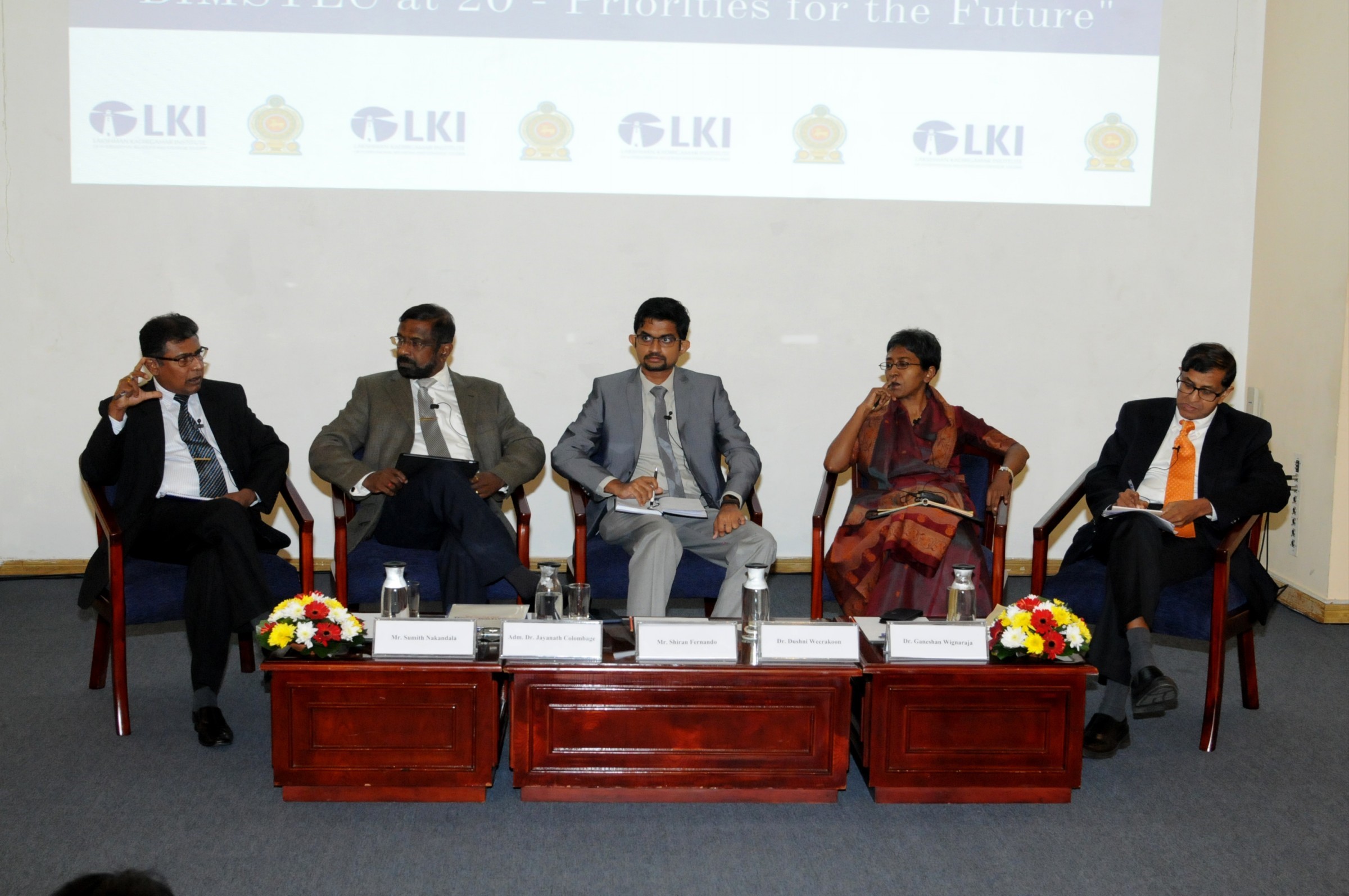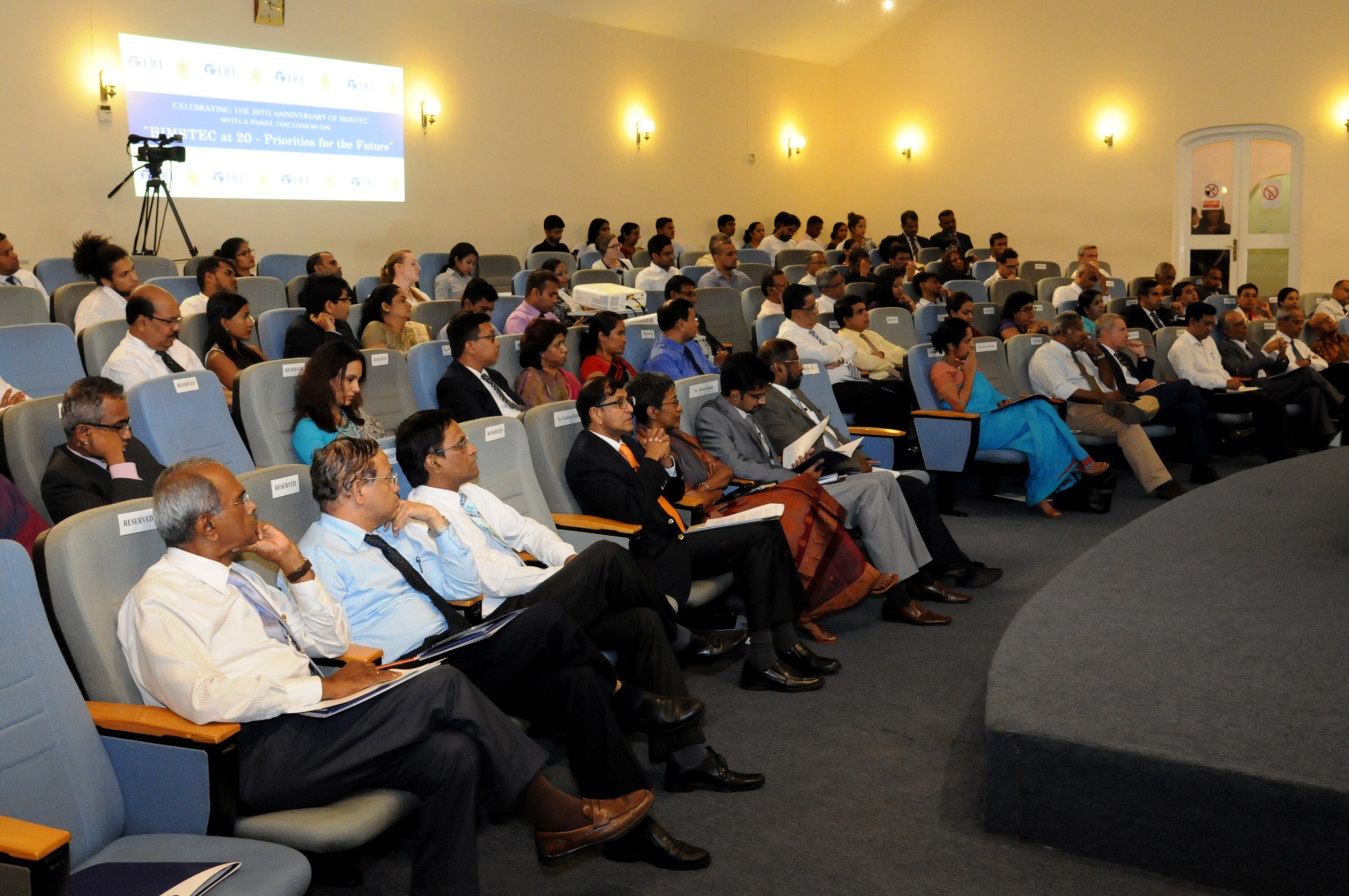
Keynote address by Mrs. Grace Asirwatham, State Secretary, Ministry of Foreign Affairs at a dialogue on “BIMSTEC AT 20 – PRIORITIES FOR THE FUTURE” hosted by the Lakshman Kadirgamar Institute and the Ministry of Foreign Affairs on 8 December 2017
On this historic occasion of the 20th Anniversary of the Bay of Bengal Initiative for Multi-Sectoral Technical and Economic Cooperation (BIMSTEC), I am privileged to deliver the keynote address to a distinguished gathering.
BIMSTEC took shape at a time when the concept of regionalism was gaining momentum. World economic developments, and the resurgence of Asia as the economic powerhouse with the emergence of China and India as engines of growth, accentuated the importance of South Asia and Southeast Asia for economic integration in Asia.
BIMSTEC means connectivity, engagement and prosperity. It is widely regarded as a product of convergence of India’s ‘Act East’ policy and Thailand’s ‘Look West’ policy. BIMSTEC is also considered as a bridge between South Asia and Southeast Asia and it is a natural affiliation between SAARC and ASEAN. Further, it is said that BIMSTEC combines focus on the Bay of Bengal and the Himalayas. These fertile thoughts and assumptions signpost the enormous potential of BIMSTEC as a sub-regional bloc.
BIMSTEC has entered the third decade of its journey in realising its objectives. Relatively young compared to other regional arrangements in Asia, BIMSTEC is striving to achieve its full potential for which the member countries’ resolute support and cooperation is a crucial prerequisite.
BIMSTEC was established by seven member countries – namely Bangladesh, India, Sri Lanka, Thailand, Myanmar, Bhutan and Nepal – to work together to optimise their capabilities, competencies and resources, with a resolve to develop their economies and eventually achieve the lofty goal of a Bay of Bengal Economic Community.
The objectives of the sub-regional initiative under the Bangkok Declaration were to create an enabling environment for rapid economic development of the sub-region, encourage a spirit of equality and partnership, and promote active collaboration and mutual assistance in the areas of common interest of the member countries.
BIMSTEC initially focused on six priority areas and it has now identified 14 priority areas, namely: trade and investment; transport and communication; energy; tourism; technology; fisheries; agriculture; public health; poverty alleviation; counter-terrorism and transnational crime; environment and natural disaster management; culture; people to people contact; and climate change. It is felt that the high number of priority areas may have hindered the progress of BIMSTEC. Of these, areas such as trade, investment, connectivity, and people to people relations require utmost attention and focus in terms of policy, infrastructure, funding and overall concerted and coordinated action by BIMSTEC.
BIMSTEC has come of age in a relatively short period. Although it has achieved modest progress in the last 20 years, it evolved over the years, withstanding all odds including disinterest, lack of commitment, political tensions, political instability and the varied expectations and dissimilar development status of member countries.
Regardless of the fact that the membership of BIMSTEC is diverse-comprising developing countries, fast developing countries and leased developed countries- together, as a sub-regional bloc it has macroeconomic strengths. BIMSTEC is an opportunity for pooling of the complementary strengths of South Asia and Southeast Asia. BIMSTEC is home to 1.5 billion people, which is 21 per cent of the world population, with a collective GDP of US$ 2.85 trillion, an average economic growth of 6.5 per cent and intra-regional trade worth of US$ 77 billion. Further, it has substantial untapped natural resources and human resources, which are most essential for mutual cooperation and prosperity.
Sri Lanka held the chairmanship of BIMSTEC from 2002-2003; during which period the importance of the political commitment of member countries was underlined for promoting a more intensified sub-regional cooperation. Sri Lanka will yet again be the Chair of BIMSTEC next year after the 5th Summit of BIMSTEC Leaders in Nepal.
The 20th anniversary of BIMSTEC provides us with an opportunity to take stock of the achievements and failures and to chart a way forward. It is also important in the context of Sri Lanka’s impending chairmanship to deliberate on injecting new dynamism and introducing added vitality, for making BIMSTEC more competent to fulfill its objectives.
As BIMSTEC is a membership-driven organization, it is also important for the Chair country to be active in providing robust leadership, to implement the decisions, and to create interest and momentum in the organization. It should also adopt a theme for focused promotion during its chairmanship. Sri Lanka should further endeavor to provide outstanding leadership and add impetus to BIMSTEC during its upcoming chairmanship.
In order to sustain the commitment of member countries to the progress in BIMSTEC, it may be crucial to adapt a troika system comprising current Chair, former Chair and future Chair of BIMSTEC who will work together to ensure the organization is on track in its progress. This arrangement will strengthen the leadership of the organization, compelling all members to demonstrate their commitment through cooperation.
Unlike in other regional organizations, the BIMSTEC Declaration has not provided for partnering with non-member countries and organizations as Observers or Dialogue Partners, who could contribute to the advancement of the objectives of BIMSTEC by contribution of funds, funding special projects, capacity building, sharing knowledge and expertise and other assistance. Such arrangements are normal and extremely beneficial if used properly. This will bridge the resource gap in the region. In this regard, cooperation and engagement with regional and international financial institutions is also vital.
Twenty years have passed since BIMSTEC’s Declaration was adopted. Considering the extensive transformation which has taken place in the region, as well as the impact of globalisation on the member countries, there is a need to revisit the Declaration to make it more relevant, coherent and strong in policy and structure, incorporating the present requirements and aspirations of the membership.
BIMSTEC should also actively engage in outreach activities, together with member countries- to gain from similar organisations and increase its capacity by interacting with UN agencies and international and regional organizations, on a subject or issue basis.
Gaining visibility in the international arena is necessary for a growing sub-regional organization, which can be achieved through obtaining observer status in United Nations General Assembly (UNGA) and other regional organizations. Such an arrangement will elevate the status of BIMSTEC which will in return bring forth benefits by way of recognition, financial assistance, expert assistance, market access etc.
BIMSTEC has a Network of Policy Think Tanks which is tasked to deliberate on the strategy for promoting connectivity and people to people contact. It would also be beneficial to have track 1.5 and track 2 forums for dialogue on all issues in focus under BIMSTEC. This will help the organization to brainstorm on opportunities and challenges for regional cooperation and to develop analytical views on current issues related to priority areas, technological advancements, and policy changes, and to plan and tackle emerging situations at both regional and global levels. BIMSTEC should also engage in effective public diplomacy, to create awareness in the member countries and to reach out to the people in the sub-region.
BIMSTEC took almost 17 years to establish its permanent Secretariat. It was expected that the coordination and implementation support by the Secretariat would introduce new robustness into the Organization for accelerating the benefits of cooperation. The creation of a Secretariat was seen as a breakthrough in BIMSTEC; however, its effectiveness will depend on member countries’ unfaltering commitment towards BIMSTEC.
In the meantime, a sluggish BIMSTEC received a surprise shot in the arm when India decided to introduce BIMSTEC to BRICS during its turn to host the BRICS Summit in Goa, India, in 2016. It was also a decision by India to increase its focus on BIMSTEC due to the shared pessimism in the progress of SAARC as a result of bilateral conflicts. At the BIMSTEC Retreat in Goa, the leaders pledged to make BIMSTEC stronger, more effective and result-oriented. They also agreed on an action agenda to achieve greater connectivity, trade, people to people contact and sustainable use of resources.
India has hosted many activities and provided leadership in several priority areas. However, the current renewed interest of India in BIMSTEC is a blessing in disguise, in the setting of troubled politics in South Asia. Needless to say, India’s leadership is of paramount importance to BIMSTEC.
The Senior Officials’ meeting and Ministerial meeting held in Kathmandu in August 2017 witnessed India’s exceptional keenness to impart a fresh dynamism into all areas of cooperation under BIMSTEC. At this meeting, the Indian External Affairs Minister Sushma Swaraj said in her address that:
“For India, BIMSTEC is a natural choice to fulfil our key foreign policy priorities of ‘Neighbourhood First’ and ‘Act East’”.
She also said that BIMSTEC is a natural platform to build our common future. Being the largest economy in BIMSTEC, India becomes the natural leader of this bloc to steer it to success. This enthusiasm is much required for sustained progress in BIMSTEC. The Goa Summit was a timely event to revitalize the weary BIMSTEC.
In regards to trade, it may be noted that the intra-BIMSTEC trade has grown marginally from 3.6 per cent in 2002 to 4.3 per cent in 2014. However, the full potential of intra-regional trade remains unexploited, owing to tariff and non-tariff barriers and the lack of other enabling conditions.
A much talked about subject in BIMSTEC is the long-pending Free Trade Area (FTA). A framework agreement for establishing the BIMSTEC FTA was signed after seven years of intense negotiations, including four rounds of ministerial meetings, from 1997 to 2004. BIMSTEC has already spent another 13 years on drafting the FTA agreement which is yet to be realised. Since 2004 to 2016, around 20 rounds of meetings were held under the Trade Negotiating Committee. Several deadlines were missed and the timelines set to submit negative lists and trade liberalisation schemes were not observed by certain countries. During the recent Leaders’ Retreat in Goa, it was agreed to expedite finalisation of the FTA. However, the Trade Negotiating Committee meeting has not taken place so far, apparently due to scheduling problems.
The emergence of a web of FTAs at sub regional and bilateral levels reflects the increasing appetite in the region for intense economic integration. The BIMSTEC members have already entered into bilateral and regional free trade arrangements in the region. These include the ASEAN FTA, ASEAN-India FTA, Regional Comprehensive Economic Partnership (RCEP), ASEAN India Comprehensive Economic Partnership, SAFTA, APTA, alongside India’s bilateral FTAs with Sri Lanka, Bhutan and a Treaty of Trade with Nepal. India is also negotiating with Sri Lanka an Economic and Technology Co-operation Agreement (ETCA) and an FTA with Thailand. Hence the proposed BIMSTEC FTA is more important for greater economic integration in the BIMSTEC region as a single community.
The ongoing discussion on the Trade Facilitation Agreement to formulate a legal framework to deepen and broaden cooperation in cross-border trade facilitation among the member countries will complement the FTAs and boost the overall cooperation in trade and economic activities.
Also, the proposed BIMSTEC FTA is to cover not only trade in goods, but also investment and services. The understanding is to first work on trade in goods and gradually progress to accommodating investment and services. The first phase of the process has already been prolonged for 13 years and it is obvious that negotiations to follow on the investment and services will be even more difficult, given the asymmetrical status of industrialisation, economic development, geographical location, policy factors, FDI prospects, logistic performance, quality of infrastructure and other enabling ground situations in the member countries.
BIMSTEC is designed to promote sectoral cooperation, which is being achieved through regional projects to bridge the developmental gap and nurture economic integration. BIMSTEC should focus on developing projects in the field of transport connectivity, and on trade-related infrastructure to create an enabling platform for intra-regional trade and investment. This will also reinforce the FTA negotiation process.
Connectivity is crucial for growth in cooperation under BIMSTEC and it is the essential building block for a regional integration arrangement. Enhancing connectivity has been the focus at all three Summits in the past as well as the recent Goa BIMSTEC leaders’ Retreat. In the Retreat outcome document, the BIMSTEC leaders recognised connectivity as the key promoter of regional integration and agreed to continue to promote all modes of transport linkages.
Thailand is drawing up a BIMSTEC Master Plan on Connectivity with a view to create a seamless and multidimensional connectivity, including hardware, software, people to people contact and digital connectivity for the betterment of the region. The BIMSTEC Transport Infrastructure Logistics Study (BTILS), funded by the Asian Development Bank (ADB), identified various short and long–term transport connectivity projects to be undertaken in the BIMSTEC region, which will cost around US$45-50 billion.
It is also important to strengthen public–private partnerships, cooperation among the customs authorities, immigration authorities, and ports authorities, financial institutions, shipping industry, business communities, civil societies, academia etc. This is compulsory for realising an actual functioning connectivity through people to people contact.
BIMSTEC should make maximum use of the newly created connectivity infrastructure by India under the ‘Act East policy’. Further, the various bilateral and regional connectivity infrastructures being created in the region, including the Asian Highway and the various ADB projects, should be synchronized with the connectivity plans of BIMSTEC.
Technology has become an integral part of our daily life. It is one of the core priority areas promoting science and technology for the benefit of the industry and commerce. Sri Lanka is the lead country for Technology Sector in BIMSTEC. It was proposed to set up a BIMSTEC Technology Transfer Facility (TTF) as a hub in Sri Lanka, to expand technology bases through transfer of technology, collaboration and partnerships targeted towards micro-small-and medium-scale enterprises. Technological advancement in the region will make a qualitative change in the regional cooperation. Therefore, Sri Lanka, together with the member countries, should expedite setting up of this facility to enhance cooperation in technology among member countries.
In the process of globalisation, energy security is crucial for all countries, without exception. The BIMSTEC region is endowed with large gas reserves and hydropower potential. BIMSTEC is focused on cooperation in the energy sector, to tap these resources for development, distribution and efficient utilisation. For promotion of energy, trade and investment, a suitable regulatory framework should be established to make it more market-driven.
In the field of electricity, BIMSTEC has progressed to finalise a Memorandum of Understanding (MoU) on establishing a trans-grid connectivity, which would connect all the grids of BIMSTEC Member States. This subject will be further studied for strengthening cooperation. Likewise, BIMSTEC should also focus on other energy resources for cooperation in the region.
BIMSTEC has not yet focused enough on the Indian Ocean. The Indian Ocean is a cross cutting issue, relevant to all 14 priority areas of cooperation. BIMSTEC needs to deliberate on creating a mechanism for promoting cooperation in the field of Indian Ocean maritime safety and security. It may also create links with the Indian Ocean Rim Association (IORA), the International Maritime Organisation (IMO) and other relevant institutions in this field for exchange of information, best practices and complementing implementation of decisions through concerted action in achieving common goals.
Littoral countries in the Indian Ocean are focussing on the Blue economy in order to gain the economic benefits of the ocean in a systematic and coordinated manner, as a community. The BIMSTEC leaders during the Goa Retreat agreed to deepen cooperation in the development of the Blue economy for promoting sustainable development in the BIMSTEC region.
To achieve the desired sub-regional cooperation, it is essential to have peace and security in the region. Efforts are being taken to tackle traditional and non-traditional security challenges confronted by the region. In this regard, BIMSTEC member countries have concluded a convention on anti-terrorism. Further efforts are being made to conclude a Convention on Mutual Legal Assistance in Criminal Matters.
BIMSTEC at the 20th milestone anniversary should be appreciated for its achievements. To strengthen cooperation, sincere efforts need to be made to improve policies, strategies, structure, work procedures and infrastructure.
We are in an Asian century. South Asia and Southeast Asia are well positioned to reap the benefits of the shift of the global economic epicentre towards Asia and of the rapid economic transformation taking place in Asia.
By 2020, it is anticipated that Asia will account for around 45 per cent of global GDP, one-third of global trade and one-quarter of global military spending. Therefore, the regional architecture in Asia, including regional organizations such as BIMSTEC, becoming increasingly important to maintaining regional stability and as a means of tackling the critical challenges that will arise.
To be compatible and competitive in the Asian Century, BIMSTEC should focus on the most essential requisites of the current decade, which are wide-ranging: physical connectivity, institutional connectivity, trade facilitation, infrastructure, the FTA and economic integration. These measures will inevitably promote people to people contact in the region.
I believe the member countries understand the strengths and weaknesses of BIMSTEC. They are aware of the huge potentials available for cooperation. They are also aware of the multitude of challenges confronted by BIMSTEC to achieve regional integration. We expect new vigour and added quality in the practical measures being taken in the third decade of cooperation in BIMSTEC, through enhanced partnership, collaboration and much-needed commitment.
* * *


![]() Video of Keynote Address & Panel Discussion is available at the following : https://www.youtube.com/watch?v=VswjoPUUh0M
Video of Keynote Address & Panel Discussion is available at the following : https://www.youtube.com/watch?v=VswjoPUUh0M




